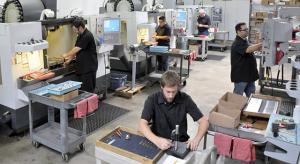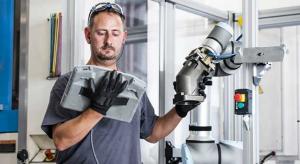All Features

Gleb Tsipursky
The pandemic has forced organizations to recognize that they need to address proximity bias to adapt their work culture to the hybrid and remote future of work. Proximity bias is the unconscious perception that those with close proximity to their team or leader are better employees. These employees…

Bruce Hamilton
We had been working with the Toyota Production System Support Center (TSSC) for two years to build a model line in our assembly department. As we moved from small batch production to one-by-one, the results had been astounding: Customer lead time reduced from two weeks to one day, crew size cut in…

Gleb Tsipursky
The pandemic forced leaders to reconcile with the need for effective hybrid and remote team management strategies, including in performance evaluations. Research has shown the benefits of moving away from large-scale quarterly or annual performance reviews.
Instead, systematic, frequent, and brief…

The Un-Comfort Zone With Robert Wilson
When I was a kid, I was enamored of cigarette-smoking movie stars. When I was a teenager, some of my friends began to smoke; I wanted to smoke too, but my parents forbade it. I was also intimidated by the ubiquitous anti-smoking commercials I saw on television warning me that smoking causes cancer…

Roderick Swaab, Robert Lount, Seunghoo Chung, Jeanne Brett
The higher the stakes, the more likely a negotiation is conducted by two teams rather than two individuals. Just think about corporate mergers and acquisitions, lawmaking in government, or international trade agreements. All these types of negotiations require varied expertise with multiple people…

Gleb Tsipursky
‘I don’t see how we can replace the serendipitous idea generation of hallway conversations,” said Saul, the director of quality management for a 1,500-employee enterprise software company, during a planning meeting about the company’s post-vaccine return to the office. “If we don’t return to the…

Knowledge at Wharton
Most managers dread giving feedback. Offering a blend of praise and criticism is supposed to help your team members do more of what they’re good at and improve in areas where they’ve missed the mark. But research shows it rarely works that way. In her book How to Change (Ebury Digital, 2021),…

Sachin Waikar
‘Diversity means lots of things,” says Amir Goldberg, an associate professor of organizational behavior at Stanford Graduate School of Business. “These days, it evokes the idea of race or gender, but it’s also about how people think.”
Beyond their demographic differences, people working in a group…

Ben Bensaou
For many organizations, the biggest challenge of innovation isn’t coming up with good ideas—it’s making sure those good ideas are noticed and acted upon. This is a particular challenge for multinationals, such as global pharmaceutical and health company Bayer, which have thousands of staff spread…

Daniel de Wolff
Most successful entrepreneurs know that simply inventing a smart or disruptive technology isn’t enough to make customers come running. Among other things, business development involves connecting with the right people in the corporate hierarchy. Yet aspiring entrepreneurs often underestimate the…

Rebecca Saenz
There are three key things cobot developers and employers using cobots must remember when considering implementation: 1) human life takes precedence, 2) human life takes precedence, and 3) human life takes precedence.
Dictionary.com defines cobot as “a computer-controlled robotic apparatus that…

Katie Rapp
For manufacturers, artificial intelligence (AI) can be a game changer. Greater efficiencies, lower costs, improved quality, and reduced downtime are just some of the potential benefits. This technology isn’t just for large manufacturers. High-value, cost-effective AI solutions are more accessible…

Ben Bensaou
A manufacturer of the fabric used to reinforce car tires might not seem an obvious source of innovation inspiration. But in just a few years, Kordsa, a part of the Turkish industrial conglomerate Sabancı Group, transformed itself from a price-driven maker of commodity products into a provider of…

Gleb Tsipursky
Are you worried that having hybrid and, especially, full-time remote employees will undermine employee on-the-job learning, integration into company culture, and intra- and inter-team collaboration? This issue recurrently came up with organizations that I guided in developing strategies for…

Arron Angle
I just received and read the “2021 ASQE Insights on Excellence Executive Brief.” The brief examines how quality initiatives are progressing in the digital era, based on the views and experiences of 542 executives and quality professionals from global enterprises. Here we go again, I thought.
Yes,…

Gleb Tsipursky
Organizations will need to pivot their corporate culture if they wish to survive and thrive in the world of virtual collaboration after the pandemic. The most important changes will stem from the wide-scale and permanent shift to hybrid and fully remote modes of working.
Between 65 percent to 75…

Bruce Hamilton
In 1996, the TSSC (Toyota Production System Support Center) began working with my company to create one-by-one production capability in our product assembly. Previous to TSSC’s assistance, we’d moved the furniture and machines into cells, creating the appearance of flow production, but we lacked…

Henning Piezunka, Vikas Aggarwal, Hart Posen
Does this situation sound familiar? You’re sitting in a meeting, and you and your colleagues are energetically discussing how to handle an important issue or challenge. Ideas and suggestions are bouncing around so fast that the designated note-taker can barely keep up. Then a new voice chimes in,…

Matt Fieldman
In September 2021, I was fortunate to attend the FABTECH conference in Chicago, a sprawling trade show with what must have been billions of dollars of manufacturing equipment on display: robots, automation, 3D printers, you name it. While there, I had the privilege of listening to a keynote address…

Alena Komaromi
Negotiators are often told they should eschew competitive negotiations, where parties fight for what’s on the table. They should instead increase the size of the pie and seek win-win scenarios. But in reality, competitive negotiations are often unavoidable. Sometimes, there doesn’t seem to be any…

Gleb Tsipursky
It’s too bad that so many rely on their intuition for their decision-making process. From former President Donald Trump, to Steve Jobs, and even allegedly Mark Twain, gut reactions are viewed as something almost magical, acquired either by hard-earned experience or possessed by a select few young…

Zach Winn
More and more people are doing their shopping from home these days, and whether they’re ordering groceries, home office equipment, or Covid-19 tests, they increasingly expect their deliveries to be fast and on time.
Companies have struggled to keep up with the rise in orders and expectations. One…

Knowledge at Wharton
Food Co., a pseudonym for a large food processing plant in the U.S. Northeast, had been operating successfully for several years when the plant manager realized he had a problem he couldn’t solve alone.
The employees did their jobs well, but they didn’t seem to care much about taking care of each…

Felipe Monteiro
Bringing innovation inside an established firm, even one that has created novel ideas in the past, is not as simple as just purchasing bundled external knowledge and expecting it to work wonders at headquarters right away.
Enel CEO Francesco Starace’s mandate was to create long-term sustainable…

Matt Fieldman
This article is the sixth in a monthly series by the the America Works initiative. As a part of the Manufacturing Extension Partnership (MEP) National Network’s goal of supporting the growth of small and medium-sized manufacturing companies, this series focuses on innovative approaches, and…